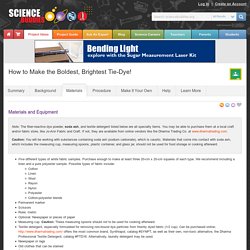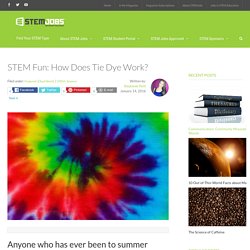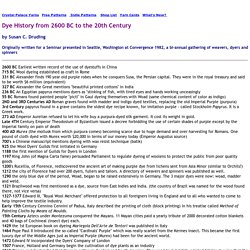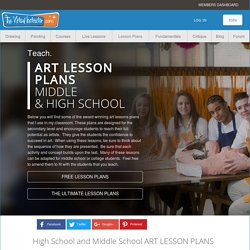

How to Make the Boldest, Brightest Tie-Dye! Please ensure you have JavaScript enabled in your browser.

If you leave JavaScript disabled, you will only access a portion of the content we are providing. <a href="/science-fair-projects/javascript_help.php">Here's how. </a> Abstract The clothes you wear are made of fibers that come from many different sources. Objective Test how strongly fiber-reactive dyes color different fabric types.
Credits Sandra Slutz, PhD, Science Buddies Teisha Rowland, PhD, Science Buddies This science fair project is based on these sources: Schisler, L.J. (2003). Cite This Page MLA Style Science Buddies Staff. APA Style Science Buddies Staff. (2014, September 2). Share your story with Science Buddies! I Did This Project! Last edit date: 2014-09-02 Introduction From the shrouds of mummies in ancient Egypt, to the ball gowns of ladies in the Victorian era, to the tie-dyed shirts of modern hippies, dyed cloth has played an important role in human society. Figure 1. Terms and Concepts Questions Bibliography. STEM Fun: How Does Tie Dye Work? - STEMJobs. History: Tie dying has been around long before the 1960s and 1970s – the decades many people associate with the colorful trend.

Before the term “tie dye” became popular, the practice was known as Shibori, a Japanese term that includes a wide variety of dyeing techniques. The practice has been used by many different cultures over the course of the past 6,000 years. How To Tie Dye: Nowadays, tie dye works by taking a white (or light colored) article of clothing, folding or crumpling it up, and putting different colored dyes on sections of the clothing.
How to Make Goldenrod Paper - Educational Innovations Blog. By: Tami O’Connor Gone But Not Forgotten Many years ago at Educational Innovations we had heard rumors that our wonderful goldenrod paper that served as an easy to find indicator paper was being discontinued for environmental reasons.

If you haven’t seen it before, it is was a golden-yellow paper that turned a deep red when it came in contact with a base like washing soda or Windex®. The process was reversed if an acid such as vinegar was sprayed on the paper. Apparently, because the fibers in the paper were saturated with golden colored dye, Goldenrod paper was not able to be recycled. Knowing that shortly it would be impossible to find, and also knowing that teachers around the world loved this paper, Educational Innovations bought up as much as we could feasibly fit in our warehouse. Since it is still referenced in many science journals, we have decided that teachers might be interested in making their own goldenrod paper to use with their students. History of Dyes from 2600 BC to 20th Century - natural dyes, synthetic. Crystal Palace Yarns Free Patterns Indie Patterns Shop List Yarn Cards What's New?

By Susan C. Druding Originally written for a Seminar presented in Seattle, Washington at Convergence 1982, a bi-annual gathering of weavers, dyers and spinners 2600 BC Earliest written record of the use of dyestuffs in China715 BC Wool dyeing established as craft in Rome331 BC Alexander finds 190 year old purple robes when he conquers Susa, the Persian capital. These pages were especially prepared by Susan C. History of Dyes from 2600 BC to 20th Century - natural dyes, synthetic. Grades 9-12 - Lesson Plans by Grade Level. High School Art Lessons- Categorized by Medium. Free Art Lesson Plans-Visual Art Lesson Plans. High School and Middle School ART LESSON PLANS Art Lesson Plans For Beginning Artists- Level One High School Color Theory Art Lesson Plan Students are exposed to color theory by creating a painting using tempera paint that is sectioned according to specific color themes.

Clay Figures Sculpture Lesson Students construct a clay figure using "scoring a slipping". A challenging assignment that requires developing the clay in various stages. Figure Drawing Students create gesture drawings from live models, then work from photos to create a proportional figure drawing with oil pastels. Lichtenstein Pics Drawing Lesson After learning about artist, Roy Lichtenstein, students create their own Pop Art drawing using oil pastels, working from newspaper comic clippings. Lessons & Activities. P&G Everyday United States (EN) Make festive yarn balls with our simple instructions to add some flash to parties or your home décor.

By: Shelly Reese Want to add a festive touch to your home décor? Yarn balls are an inexpensive and versatile décor trick. They also make for easy party decorations. MaterialsBalloonsPlastic bags or a dropcloth to cover the floorCooking spraySchool glue1/2 cup cornstarch1/4 cup hot waterScissorsYarnA mixing bowl Instructions Blow up balloons to different sizes (filling balloons only halfway will help you achieve a more spherical shape) and knot each balloonCreate a drying area (If you’re working outdoors or in the garage, hang up a clothesline. Wrap in all directions, top to bottom and side to sideWhen you’re satisfied with the wrapping, cut the string.Repeat the process with the remaining balloonsAllow the balloons to dry completely. Tip: If the ball collapses a little, inflate a new balloon inside the ball to gently push the collapsed spot back into place, and then remove the balloon. How to Make Goldenrod Paper - Educational Innovations Blog. Chemistry - Goldenrod Color-Changing Paper - 100 sheets.
True goldenrod paper is made from a dye which is an acid-base indicator.

This paper turns bright red in bases such as ammonia, baking soda or washing soda and returns to bright yellow in acids such as vinegar or lemon juice.